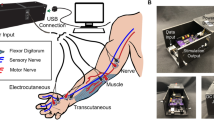Summary
The Neurometer is a variable constant current sine wave stimulator, and has recently been proposed as a simple non-invasive and quantitative measure of peripheral nerve function. The device is portable and battery operated; assessment of upper and lower extremities takes only a few min, in contrast to conventional assessment techniques. In order to assess its potential in the quantification of diabetic neuropathy, detection thresholds for constant current electric sine wave stimulation were measured at three different frequencies in different sites in 31 healthy control subjects and 90 diabetic patients with and without neuropathy. The device provides good discrimination between neuropathic and non-neuropathic groups (p<0.001) and is quick and easy to use. Comparisons with results of conventional tests of nerve function show that high frequency detection thresholds correlate best with tests of large fibre function (r= 0.42–0.69, p<0.001), and low frequency detection thresholds correlate with tests of small fibre function (r=0.34–0.46, p<0.005). It is concluded that the device may be a simple and comprehensive way of assessing peripheral nerve function.
Article PDF
Similar content being viewed by others
Avoid common mistakes on your manuscript.
References
Brown MJ, Asbury AK (1984) Diabetic neuropathy. Ann Neurol 15: 2–12
Birke JA, Sims DS (1986) Plantar sensory threshold in the ulcerative foot. Lepr Rev 57: 261–267
Jamal GA, Hansen S, Weir AI, Ballantyne JP (1985) An improved automated method for the measurement of thermal thresholds. 1.normal subjects. J Neurol Neurosurg Psychiatry 48: 354–360
Bertlesmann FW, Heimans JJ, Weber EJM, Van der Veen EA, Schouten JA (1985) Thermal discrimination thresholds in normal subjects and in patients with diabetic neuropathy. J Neurol Neurosurg Psychiatry 48: 686–690
Fowler CJ, Carroll MB, Burns D, Howe N, Robinson K (1987) A portable system for measuring cutaneous thresholds for warming and cooling. J Neurol Neurosurg Psychiatry 50: 1211–1215
Guy RJC, Clark CA, Malcolm PN, Watkin PJ (1985) Evaluation of thermal and vibration sensation in diabetic neuropathy. Diabetologia 28: 131–137
Boulton AJM, Hardisty CA, Betts RP, Franks CI, Worth RC, Ward JD, Duckworth T (1983) Dynamic foot pressure and other studies as diagnostic and management aids in diabetic neuropathy. Diabetes Care 6: 26–33
Dyck PJ, Karnes J, O'Brien PC, Zimmerman IR (1984) Detection thresholds of cutaneous sensation in humans. (In) Dyck PJ, Thomas PK, Lambert EH, Bunge R (eds) Peripheral neuropathy. WB Saunders, Philadelphia, pp 1103–1138
Williams G, Gill JS, Aber V, Mather HM (1988) Variability in vibration threshold among sites: a potential source of error in biothesiometry. Br Med J 296: 233–235
Dyck PJ (1988) Detection, characterisation, and staging of polyneuropathy: assessed in diabetics. Muscle and Nerve 11: 21–32
Consensus statement (1988) Report and recommendations of the San Antonio conference on diabetic neuropathy. Diabetes 37: 1000–1004
Boulton AJM, Knight G, Drury J, Ward JD (1985) The prevalence of symptomatic, diabetic neuropathy in an insulin-treated population. Diabetes Care 8: 125–128
Katims JJ, Naviasky EH, Rendell MS, Ng LKY, Bleeker ML (1987) Constant current since wave transcutaneous nerve stimulation for the evaluation of peripheral neuropathy. Arch Phys Med Rehabil 68: 210–213
Boulton AJM, Ward JD (1986) Diabetic neuropathies and pain. Clin Endocrinol Metab 15 (4): 917–931
Ganong WF (1981) Review of medical phyisology, 10th edn. Lange, Los Altos, pp 29–42
Brazier MAB (1968) The electrical activity of the nervous system, 3rd edn. Pitman Medical, London, pp 79–91
Torebjork HE, Hallin RG (1974) Responses in human A and C fibres to repeated electrical intradermal stimulation. J Neurol Neurosurg Psychiatry 37: 653–664
Talbot WH, Darian Smith I, Kornhuber HH, Mountcastle VB (1968) The sense of flutter-vibration: comparison of the human capacity with response patterns of mechanoreceptive afferents from the monkey hand. J Neurophysiol 31: 301–334
Vallbo AB, Hagbarth K-E, Torebjork HE, Wallin BG (1979) Somatosensory, Proprioceptive and sympathetic activity in human peripheral nerves. Physiol Rev 59 (4): 919–957
Author information
Authors and Affiliations
Rights and permissions
About this article
Cite this article
Masson, E.A., Veves, A., Fernando, D. et al. Current perception thresholds: a new, quick, and reproducible method for the assessment of peripheral neuropathy in diabetes mellitus. Diabetologia 32, 724–728 (1989). https://doi.org/10.1007/BF00274531
Received:
Revised:
Issue Date:
DOI: https://doi.org/10.1007/BF00274531




